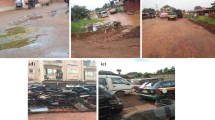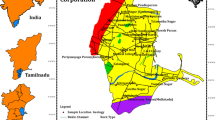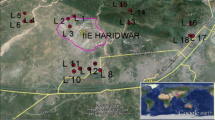Abstract
An integrated study of health risk assessment, pollution indices, and factor analysis was carried out to assess the pollution and heavy metal sources in groundwater of the Delhi-Haryana boarder, India. A total of 25 groundwater samples were analyzed for major ions, and 13 samples were analyzed for 6 elements (Mn, Cu, Cd, Zn, Fe, and Pb). Most of the samples show a high concentration of nitrate, fluoride, and EC and indicate the influence of anthropogenic activities. Out of the elements analyzed, the elements like Cd, Pb, and Fe exceed the prescribed limits of WHO standard for drinking water. Health risk index (HRI) values reveal risk of toxicity through oral pathways is less, as all trace elements are < 1. Six locations (Sl. No. 2, 7, 8, 10, 11, and 13) are considered as the most polluted based upon their heavy metal pollution index (HPI). The distribution pattern of these locations indicates that the pollution is due to anthropogenic activities. Sources of the pollution were determined by statistical analysis. There are three major factors like mining and agriculture, geogenic source, and crusher zone activities and domestic activities that are mainly responsible for the heavy metal pollution in the study area.



Similar content being viewed by others
References
ATSDR U (1999) Toxicological profile for mercury (update). US Agency for Toxic Substances and Disease Registry, Atlanta
Biney CA, Christopher AB (1991) Trace metal concentrations in fish and sediments from the WIWI: a small urban river in Kumasi, Ghana. Trop Ecol 32(2):197–206
BIS (2012), Drinking water specifications 2nd revision. Bureau of Indian Standards (IS 10500: 2012). New Delhi. ftp://law.resource.org/in/bis/S06/is.10500.2012.pdf (2012)
CGWB (2008) Ground Water Year Book, 2007-2008, National Capital Territory, Delhi. Central Ground Water Board, New Delhi
Chadha DK (1999) A proposed new diagram for geochemical classification of natural waters and interpretation of chemical data. Hydrogeol J 7 (5):431–439
Demirel S, Tuzen M, Saracoglu S, Soylak M (2008) Evaluation of various digestion procedures for trace element contents of some food materials. J Hazard Mater 152(3):1020–1026
Drury CF, Voroney RP, Beauchamp EG (1991) Availability of NH4+-N to microorganisms and the soil internal N cycle. Soil Biol Biochem 23(2):165–169
Edet AE, Offiong OE (2002) Evaluation of water quality pollution indices for heavy metal contamination monitoring. A study case from Akpabuyo-Odukpani area, Lower Cross River Basin (southeastern Nigeria). GeoJournal 57:295–304
IARC (2012). International Agency for Research on Cancer. A review of human carcinogens: arsenic, metals, fibres, and dusts. IARC Monographs on the Evaluation of Carcinogenic Risks to Humans.100C. Lyon, France:121–141.
Ediagbonya TF, Nmema E, Nwachukwu PC, Teniola OD (2015) Identification and quantification of heavy metals, coliforms and anions in water bodies using enrichment factors. J Environ Anal Chem 2:146
Godt J, Scheidig F, Grosse-Siestrup C, Esche V, Brandenburg P, Reich A, Groneberg DA (2006) The toxicity of cadmium and resulting hazards for human health. J Occup Med Toxicol 1(1):1–6
Huang SW, Jin JY (2008) Status of heavy metals in agricultural soils as affected by different patterns of land use. Environ Monit Assess 139(1):317–327
Karim Z (2011) Risk assessment of dissolved trace metals in drinking water of Karachi, Pakistan. Bull Environ Contam Toxicol 86(6):676–678
Khalid S, Shahid M, Dumat C, Niazi NK, Bibi I, Gul Bakhat HFS, Abbas G, Murtaza B, Javeed HMR (2017) Influence of groundwater and wastewater irrigation on lead accumulation in soil and vegetables: Implications for health risk assessment and phytoremediation. Int J Phytoremed 19(11):1037–1046
Magesh NS, Chandrasekar N, Elango L (2017) Trace element concentrations in the groundwater of the Tamiraparani river basin, South India: insights from human health risk and multivariate statistical techniques. Chemosphere 185:468–479
McKee JE, Wolf HW (1963) Water quality criteria, Calif. State Water Qua]. Control Board, Sacramento, CA, Publ. A, 3, 548
Mohan SV, Nithila P, Reddy SJ (1996) Estimation of heavy metal in drinking water and development of heavy metal pollution index. J Environ Sci Health A 31(2):283–289
Muhammad N, Banoori N, Akbar A, Azizullah A, Khan M, Qasim M, Rahman H (2016) Microbial and toxic metal contamination in well drinking water: potential health risk in selected areas of Kohat, Pakistan. Urban Water J 28:1–7
Nawab J, Khan S, Ali S, Sher H, Rehman Z, Khan K, Tang J, Ahmad A (2016) Risk assessment of heavy metals and biological contamination in drinking water of Malakand Agency, Northern Pakistan. Environ Monit Assess 188:286. https://doi.org/10.1007/s10661-016-5296-1
Panda B, Chidambaram S, Thivya C, Thilagavathi R, Tirumalesh K, Devaraj N (2020) An attempt to determine the behavior of metals and their dependent thermodynamic saturation states in the groundwater along mountain front and riparian zone. Environ Earth Sci 79(1):17
Papanikolaou NC, Hatzidaki EG, Belivanis S, Tzanakakis GN, Tsatsakis AM (2005) Lead toxicity update. A brief review. Med Sci Monit 11(10):329–336
Prasad B, Bose JM (2001) Evaluation of the heavy metal pollution index for surface and spring water near a limestone mining area of the lower Himalayas. Environ Geol 41:183–188
Prasanna MV, Praveena SM, Chidambaram S, Nagarajan R, Elayaraja A (2012) Evaluation of water quality pollution for heavy metal contamination monitoring: a case study from Curtin Lake, Miri oCity, East Malaysia. Environ Earth Sci 67:1987–2001. https://doi.org/10.1007/s12665012-1639-6
Puthiyasekar C, Neelakandan MA, Poongothai S (2010) Heavy metal contamination in bore water due to industrial pollution and polluted and non-polluted seawater intrusion in Thoothukudi and Tirunelveli of South Tamil Nadu, India. Bull Environ Contam Toxicol 85:598–601. https://doi.org/10.1007/s00128-010-0152-4
Rajgopal (1984) Ground-water quality assessment for public policy in India. First Annual Report. Department of Geography. IOWA Univeristy, Iowa City
Rattan RK, Datta SP, Chhonkar PK, Suribabu K, Singh AK (2005) Long-term impact of irrigation with sewage effluents on heavy metal content in soils, crops and groundwater—a case study. Agric Ecosyst Environ 109(3-4):310–322
Ravindra K, Mor S (2019) Distribution and health risk assessment of arsenic and selected heavy metals in Groundwater of Chandigarh, India. Environ Pollut 250:820–830
Selvam S, Venkatramanan S, Singaraja C (2015) A GIS-based assessment of water quality pollution indices for heavy metal contamination in Tuticorin Corporation, Tamilnadu. India Arab J Geosci 8:10611–10623. https://doi.org/10.1007/s12517-015-1968-3
Ukah BU, Egbueri JC, Unigwe CO, Ubido OE (2019) Extent of heavy metals pollution and health risk assessment of groundwater in a densely populated industrial area, Lagos, Nigeria. Int J Energy Water Res 3(4):291–303
WHO (2004) Guidelines for Drinking Water Quality (3rd Edn.). 1, Recommendation, Geneva, 515
WHO (World Health Organization) (2006) Guidelines for drinking water quality, First Addendum to third ed. Recommendations, vol 1, Geneva, Switzerland.
WHO (World Health Organization). (2011). Guidelines for drinking-water quality (4th ed.). http://www.whqlibdoc.who.int/publications/2011/9789241548151_eng.pdf . Accessed 01/15/ 2011.
Acknowledgments
The authors are thankful to the anonymous reviewers who have made significant contributions to the quality of this publication. This study did not receive specific grants from public, commercial, or non-profit sector funding agencies.
Author information
Authors and Affiliations
Corresponding author
Ethics declarations
Conflict of interest
The author(s) declare that they have no competing interests.
Additional information
Responsible Editor: Venkatramanan Senapathi
This article is part of the Topical Collection on Recent advanced techniques in water resources management
Supplementary Information
ESM 1
(DOCX 185 kb)
Rights and permissions
About this article
Cite this article
Nathalia, D., Suresh, A. & Panda, B. Assessment of ground water pollution through metal index analysis and its source identification along the Delhi-Haryana boarder, India. Arab J Geosci 14, 759 (2021). https://doi.org/10.1007/s12517-021-06905-x
Received:
Accepted:
Published:
DOI: https://doi.org/10.1007/s12517-021-06905-x




